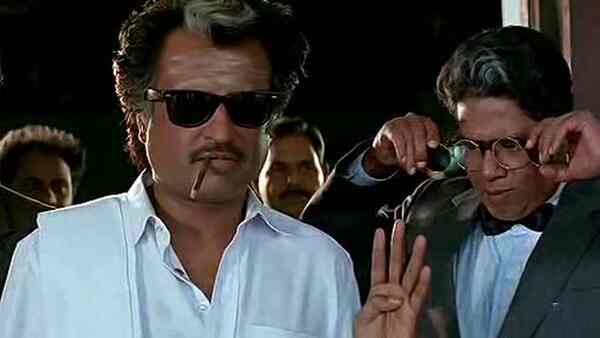30 years of Annamalai: There can only be one Rajinikanth, says filmmaker Suresh Krissna
In conversation with the Annamalai director, Suresh Krissna.

Last Updated: 12.47 AM, Jun 28, 2022
The greatest virtue of any actor is realising his limitations. “Rajinikanth clearly knows what he can, and cannot,” smiles filmmaker Suresh Krissna, who directed the Superstar in Annamalai, Baashha, Veera and Baba.
Excerpts from an interview:
Could you recall how you were brought on board to direct Annamalai at the last minute?
Vasanth (of Keladi Kanmani-fame) was to direct the film first, but opted out, owing to personal reasons. I was working on Love, a Hindi film with Salman Khan, then. K Balachander, the producer of Annamalai, sent an assistant to pick me up from the airport post-March 8, 1992. I went to KB sir's home, not knowing why he wanted to meet me. Eventually, I was told the puja of Annamalai was scheduled for March 11, and I had to take the reins as the director. I didn't know how to react to it, as he was my mentor, and I had worked with KB sir on 14 films. I realised it was a huge responsibility. When the project came to me, I didn't know its story, but later, writer Shanmugasundaram narrated it to me.
When did you meet Rajinikanth, and what was your first meeting with him like?
At the time of the Ek Duuje Ke Liye shooting, I remember Rajinikanth saying the Hindi film should do wonders for Kamal Haasan. Although I had assisted KB sir for seven years, I didn't get to interact with Rajinikanth much. I had met him only twice, and I was familiar only with Kamal Haasan. It was quite a formal meeting, on day one. We spoke for sometime. Rajinikanth pointed out a few changes that he wanted in the Annamalai script. But, somehow, I felt he wasn't entirely comfortable with me. I wanted Rajinikanth to understand that I was a jovial person. “Namba serndhu team-a work pannaa, kandippa, hit kudukkalaam,” I told him. He showed me a thumbs-up. The rest, as they say, is history. We started shooting on March 11, 1992. The makers had locked the release date, which was in three months. I had to shoot and do song recordings and dubbing. Everything was sheer madness.
In the 90s, Rajinikanth was a larger-than-life hero. How did you bring him into the universe of Annamalai?
Honestly, I didn't know that Rajinikanth was a big deal then. I watched Hindi films, and I didn't know of the crazy fan-following the man has. You don't make films like Annamalai. They happen to you. Even today, I don't know why Annamalai and Baashha became cult classics. I think it was simply magic. If you sit and analyse, you can't derive straight answers to why the film is still talked about. By the time I finished shooting Annamalai, I became a fan of Rajinikanth. The process was magical, too! And of course, the rags-to-riches story became its own genre. Rather, the Rajinikanth genre.
Absolutely. But, how did you create those magical theatrical moments? You revisit the film today, but you still end up clapping for those scenes.
Thank you! You give a scene to Rajinikanth, he'll add his magic to it. He's a superstar, but there's a great performer in him. He can pull off any expression with little or no effort. Having directed him in four films, I confidently say there can only be one Rajinikanth. An ordinary dialogue sounds/appears extraordinary when he mouths it. And, that's why he's the Superstar. Even at his peak, he enjoyed pushing himself to breathe life into his role. Rajinikanth is humble to a fault and doesn't like to overplay his achievements. What baffles me is that he treats his stardom with a sense of detachment.
I wasn't sure if he would trust me. Because, I had travelled with KB sir, and directed Kamal Haasan. Their styles were different from that of Rajinikanth's. But, in a week, Rajinikanth told me he was satisfied with my work.

Annamalai was the first film to have the flashing 'Superstar Rajni' title card in blue and yellow. Whose idea was that?
When I ran this idea by him in the beginning, he found it embarrassing. So, I had to seek KB sir's help to get this done. (Laughs) The title card was a sort of gift to his fans then. We did that when there was no CG. We roped in special editors from Prasad Studios, and it took two months for them to complete the work, frame-by-frame. Deva's music was the icing on the cake. When Rajinikanth saw it for the first time in the preview theatre, he was taken in for a pleasant surprise.
Where did you shoot the important scenes of Annamalai, and how did the looks of Rajinikanth get finalised?
Rajinikanth has an innate aura and style. Ukkarum bodhe style-a ukkaaruvaaru! And, that's not easy. Trust me, we didn't do anything extra. I won't take the entire credit for pulling off a historic film like Annamalai, as it was a team effort. The escalator scenes involving Radha Ravi, Sarath Babu, Rajinikanth and Janagaraj were shot at The Oberoi, Mumbai. We would have conveyed the overall crux of the film, in that one. I remember we had asked for six hours to shoot those portions, but we were given only two hours; from 3 to 5 pm. The whole day was insane. But, I'm glad it became the talking point of Annamalai!
Are you a fan of mass movies yourself?
I love commercial cinema, even though I enjoy watching serious films. I was quite happy, making films out of scripts that fell on my lap. But I have to be able to connect to it on some level. Let me tell you, realistic cinema and commercial cinema are not anti each other. At the end of the day, films are the medium of telling stories visually. Making money has become a crucial part of filmmaking; realistic cinema or otherwise.
(Annamalai streams on Amazon Prime Video)

 Premium
Premium